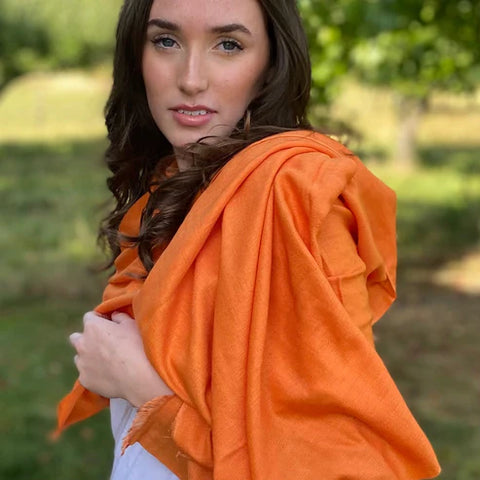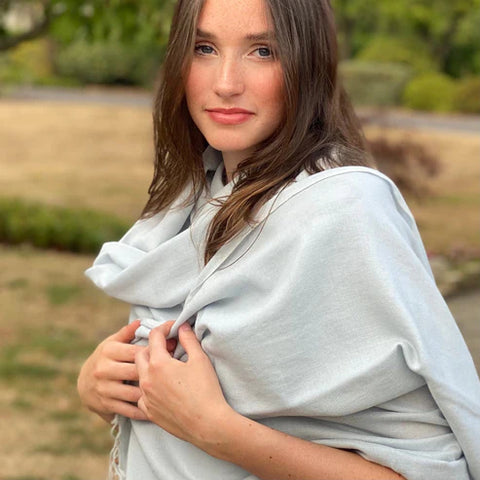The History of Cashmere: What is Pashmina Made Of?
One of the most luxurious, sought-after fabrics in the world, Pashmina has been a wool worn by Kings and Queens for centuries and was as popular then as it is now. At Signature Cashmere, we want to share the fascinating history of Cashmere, and what the Pashmina is made from to help you make an informed decision when making your next purchase.
The quality of the wool, the production process, the warmth, and light-weight nature of the fabric all make the Pashmina a must have in your wardrobe.
What is Pashmina Made from?
Pashmina wool is incredibly soft, making it feel luxurious and silky against the skin, but what is pashmina made from?
Pashmina is the name given to the wool derived from the neck and under-belly of the ‘Capra Hircus’ goat that thrives in the Himalayas at altitudes above 12,000 feet. At this altitude, the natural cashmere fibres are extremely fine (between 10-14 microns in diameter, or 6-8 times thinner than a human hair) which gives Pashmina garments an incredible warmth-to-weight ratio and is the explanation for its softness.
The wools are harvested from these goats during the spring when they shed their soft undercoat. These hairs are collected, separated, cleaned, combed, and spun to prepare them for being made into Pashmina garments.
How is Pashmina Different from Cashmere?
Most people use the terms Pashmina and Cashmere synonymously however there is a subtle difference. It is the species of goat that determines the difference between these two wool types.
Cashmere is crafted from the wools of Himalayan goats, but Pashmina is exclusively derived from the Capra Hircus goat. All our pashmina at Signature Cashmere is from the Capra Hircus goat and handcrafted in a small factory in Nepal.
A Brief History of Pashmina
The name, Pashmina, was derived from the word Pashm, a term for the under fleece of the Himalayan goat.
The Pashmina Shawl was discovered in the 16th century, in Kashmir. The Mughal Kings were awed by its luxurious nature and elegant touch, and it became known as a royal symbol. Then in the 19th Century, Napoleon presented a Pashmina shawl to Empress Josephine, and it became a fashion staple in France.
The Sapphire Blue Classic Pashmina is a delicately soft blend of cashmere wool and finely spun silk, hand-dyed using traditional methods. The brilliant, vivid blue colour has a very regal feel about it, drawing inspiration from the famous sapphire in Princess Diana’s engagement ring.
The Sapphire Blue Classic Pashmina is a delicately soft blend of cashmere wool and finely spun silk, hand-dyed using traditional methods. The brilliant, vivid blue colour has a very regal feel about it, drawing inspiration from the famous sapphire in Princess Diana’s engagement ring.

Why is the Pashmina so Special?
Due to its rich historical and cultural heritage, the Pashmina is an emblem of prestige, and known as one of the most luxurious accessories in the world. There are many aspects that give Pashmina this sought after reputation from the material to the craftsmanship, the cost and overall high-quality.
The goats themselves only yield between 150 – 200 grams of wool per year, this is naturally shed as the goats go into the summer season and ethically collected. The wool needs to be cleaned, sorted and then the lump of wool spun on a wooden wheel known as a Yinder, to produce the delicate fibres.
Weavers then mount this yarn onto the heddles of a handloom which has been used to weave pashmina for many centuries. This process can take several days before the final product is finished.
Different Types of Pashmina
When you’re looking at purchasing a pashmina, it’s imperative to look at the fibres used, where they are sourced and the price tag. As all these things are indicative to the quality.
The fabric blend of our Classic, Cut-Fringe, Shaded and Reversible Pashminas is 30% silk and 70% pashmina. The garment is woven with the fine silk threads running along the lengthwise 'warp' yarns and the pashmina wool is woven across the transverse 'weft' yarns of the garment. We use a 210 grade of silk in all our pashminas, the highest quality.
The silk adds a sheen and weight to the garment and the material retains the exquisitely soft warmth and elegance associated with pashmina.
The purest pashmina is made from 100% cashmere wool. Pure cashmere is extremely expensive and wholesale prices have risen considerably. We have worked hard to create a blend of Pashmina that is affordable for our customers while retaining the quality and durability our customers come to expect.
At Signature Cashmere, you can choose from one of our Cut Fringe Pashmina’s, with a feather-light softness, exquisite warmth and unmatched elegance. To one of our Classic Pashmina’s, a soft blend of cashmere wool and finely-spun silk and finished with elegant 9cm tassels.


The Quality of Our Pashmina at Signature Cashmere
There are many brands which claim to use Pashmina however there are wide variations in the quality depending on the supply chain and where the wool itself is sourced.
At Signature Cashmere, we have a long-lasting relationship with a reliable and trusted supplier in Nepal. Our supplier, Jitendra, has a small factory employing 25 local men and women in Kathmandu. Jitendra started his business in 1998 and has always produced the highest-quality pashminas and cashmere clothing for us.
Our garments are expertly hand made by skilled craftsmen and women from the local community near Kathmandu.
Pashmina Compared to Other Fabrics
People often think of fleece as the ultimate in cosy, winter ready fabrics. While fleece offers reasonable insulation, the texture and synthetic nature of the fabric means it lacks the sophistication of Pashmina. The fibres of the Pashmina wool are hollow meaning not only are the garments unparalleled when it comes to the touch, they also provide phenomenal insulation.
Due to the weight of the goat hair, pashmina provides an incredible warmth-to-weight ratio. Although wool is also derived from animal sources; it is much coarser and bulkier. Pashmina is eight-times warmer than wool.
Synthetic fibres such as polyester are affordable, but they do not offer the comfort and indulgence of Pashmina wool, they also are not able to stand the test of time and can be itchy against your skin.
You can read more about different fabrics here.

